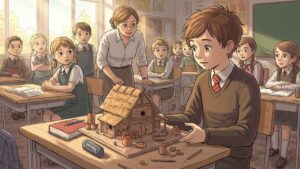The Little Match Girl: Once upon a time, in a cold and snowy town, there lived a little girl named Anna. She was called the Little Match Girl because she sold matches to earn money for her family. Anna’s family was poor, and they struggled to make ends meet.

On a bitter winter evening, as the sun began to set and the icy wind blew through the streets, Anna went out to sell matches. She wore tattered clothes and had no shoes to protect her feet from the freezing ground. With her small hands trembling from the cold, she walked door to door, hoping to sell her matches.
“Matches, matches for sale!” Anna called out, her voice barely audible over the howling wind.
But the townspeople were too busy hurrying home to pay her any attention. They ignored her, shunning her as if she were invisible. With each passing moment, Anna’s hope began to fade, and tears welled up in her eyes.
Feeling desperate and cold, Anna huddled in a corner and lit one of her matches. As the flame flickered and danced, it cast a warm glow around her, and for a moment, she felt a sense of comfort. In that brief moment of warmth, Anna imagined herself in a cozy room, surrounded by love and laughter.
But as the match burned out, the illusion vanished, leaving Anna alone in the cold once again. Desperate to feel that warmth again, she lit another match. This time, she saw a vision of a delicious feast spread out before her, with steaming dishes of food and joyful faces all around.
Anna reached out to grab a piece of bread as the match burned down, but her fingers only touched cold air. The vision faded away, leaving her hungry and longing for warmth.
With trembling hands, Anna lit another match, and this time, she saw a beautiful Christmas tree adorned with sparkling lights and ornaments. It was the most magnificent tree she had ever seen, and she couldn’t help but smile as she watched it glow.
But as the match burned out, the tree disappeared, leaving Anna again in darkness. With tears streaming down her cheeks, she lit another match, hoping to prolong the fleeting moments of happiness.
Suddenly, a voice called out to her from the darkness. “Little girl, what are you doing out here all alone?”
Anna looked up to see an old woman standing before her, her face wrinkled with concern. She reached out her hand to Anna, offering her warmth and kindness.
“I’m just trying to stay warm,” Anna replied, her voice barely above a whisper.
The old woman took Anna into her arms and wrapped her in a warm embrace. “Come with me, child. You shouldn’t be out here all alone. Let’s find you some food and shelter.”
Together, they walked through the snowy streets, until they reached a cozy little cottage nestled among the trees. The old woman welcomed Anna inside and fed her a hearty meal, filling her belly with warmth and comfort.
As Anna sat by the fire, feeling grateful for the kindness of the old woman, she realized that the true meaning of Christmas wasn’t found in material things or fleeting moments of happiness. It was found in the love and compassion we share with others, especially those in need.
With a grateful heart, Anna thanked the old woman for her generosity and kindness. As she drifted off to sleep that night, she knew that she would never forget the lesson she had learned: that even in the darkest of times, there is always hope and kindness to light the way.
More Stories – Click Here
FAQs on The Little Match Girl Story
Q: What is “The Little Match Girl” story about?
A: “The Little Match Girl” is a short story by Hans Christian Andersen about a poor young girl who tries to sell matches on a cold New Year’s Eve.
Q: What happens to the Little Match Girl in the story?
A: In the story, the Little Match Girl lights matches to keep warm and experiences vivid visions of warmth and love before tragically passing away.
Q: What is the moral of “The Little Match Girl” story?
A: The story conveys themes of poverty, compassion, and the importance of human connection and empathy for those in need.
Q: When was “The Little Match Girl” story first published?
A: “The Little Match Girl” was first published in 1845 as part of Hans Christian Andersen’s collection of fairy tales.







